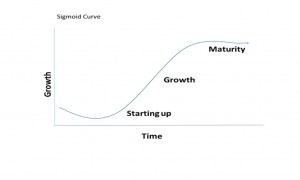Here is a very interesting question from a successful business owner:
What does growth in a business look like? ‘Typically after one year, two, three etc.? Is a business meant to continue to grow or does it plateau after a certain time line?
There is no set point at which a business should be during a specific time frame. The answer depends hugely on the type of business, the amount of money invested in the business, and not least, on the amount of time put into growing the business.

There are 3 phases every business goes through:
Phase 1 Start: often out of the passion of the owner – who struggles to get the first sale. The business owner may have had a good idea about a product and after producing it, tries hard to get customers to buy it. As a business owner, you must carefully consider how long you can afford to remain in this phase. Knowing your numbers is key to success of a business and especially in the start up phase. Most businesses fail during his phase for the simple reason that they run out of money.
You can start a business and grow at your own pace, or you can solicit the help (money) of an investor to create a start- up business. Start-ups are the type of business that are designed specifically to grow fast, and backed by an investor who is looking to get a return on their investment. It is not uncommon to see start-ups growing at a rate of 5-7% per week!
If you are not backed by an investor and are trying to build the business with your own money and time, then you should definitely decide from day one exactly how long it will take for you to get your product ready for market.
In the ideal world, you should have mapped out each phase with a timeline before you launched your business. Phase 1 is when you create the Strategic Plan of your business (where you are going and how you will get there). This plan will detail exactly what you need to do, when, how and at what expense to reach a certain point within a given time frame. For example, you decide to create a new line of sports wear. In phase 1, you define in your Strategic Plan exactly how you will design the clothing, who will manufacture it, at what cost and when will the first items of clothing be ready for market.
Phase 2 Rapid growth occurs when you have managed to convince the market that your product is what they want and need. Your challenge during this phase is to be able to supply enough product to satisfy market demands. As a business owner, you probably find yourself doing everything in the business, perhaps with the help of family or a couple of part-time employees. It is indeed an exciting phase as you are now selling your product, making money and working like mad to keep it all going. The time frame is difficult to pin down. So perhaps you should think more in terms of key metrics of your business when deciding the duration of the growth period. Key metrics are the numbers you use to gauge the development of your business. These numbers include your cost of sale, your revenue, return on investment, production costs, shipping costs, fixed costs, number of customers, average size of customer purchase. All these numbers really have several functions. First of all, they let you know if the business is generating an acceptable return on investment. Secondly, they help you analyse the performance of each department of your business, and help you determine where you can save costs or increase revenue.
Phase 3 Plateau: Your business has reached a certain level of maturity that makes you no longer a small business, but one on the verge of becoming a big one. At this phase, you really have to make your mind up where you want your business to be. If you want to grow it, then you must start creating an organisation that will take care of production, marketing, sales, finance, HR, customer service, etc. You, the business owner, can no longer expect to take an active part in each and every detail of your business’s daily activities.
Phase 3 does not mean that your business in no longer viable. It only means that it has reached a certain level of potential based on the current structure of the organisation (internal influence) and of the market (external influence).
You may decide that the size of your business at maturity is what you want and then work on keeping it at that stage. Or you may want to take your business to the next level, and in order to do that, you must rethink your Strategic Plan and reframe the question of “where do I want to go and how will I get there”.
To sum up, there is no universal answer as to how long a business remains in each phase. The answer relies on money and time.
I choose the subject of each blog from the many questions I receive on running a business. If you have any questions, please do not hesitate to contact me for a direct answer or one that become the theme of my next blog.


